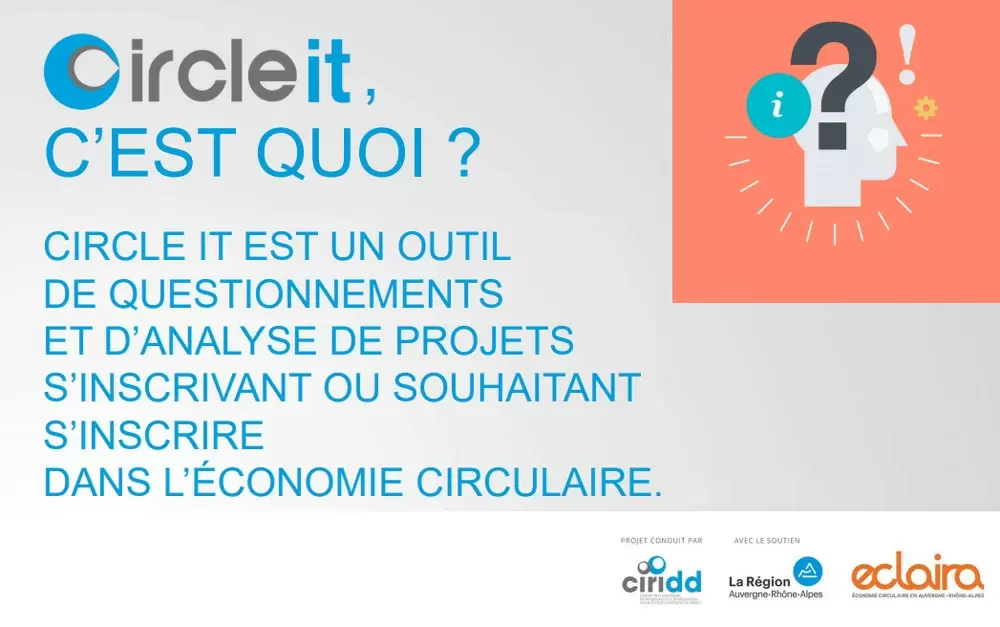CIRCLE IT... A tool to help you build your circular economy projects.

In March 2018, CIRIDD launched CIRCLE IT to mark the meeting of the Network and makes it available free of charge at www.eclaira.org. This questioning and analysis tool will help you design circular economy projects and monitor them over time.
As a decision-making tool, it aims to help a project team share a vision around a circular economy project and to define it.
Intended above all as a tool for facilitating, thinking, illustration, creativity and enrichment of circular economy projects, it is most useful when brought into play as far upstream as possible of the project and as part of collective thinking.
It targets any circular economy project, driven by any type of organization in any area, and at different stages of advancement. It is based on multi-layered questions and allows respondents to select criteria suited to the project and the supporting organization.
When developing the tool, a preliminary benchmark was produced to check whether such a tool was justified. It confirmed the value of building this questioning and analysis tool and made it possible to specify its objectives and content.
A working group was set up with experts from the circular economy, and social, environmental and economic components, such as ARACT Auvergne Rhône-Alpes, TECHTERA, Aurélien Boutaud, MACEO, ADEME and the Auvergne-Rhône-Alpes Region. It gave an opinion as to the objectives of the tool, what a circular economy project really is, and the criteria to be positioned, the structure, the ergonomics, the needs of potential users, how it would evolve, etc.
Each member tested the tool in its prototype phase on real cases and provided feedback.
In substance, the working group retained the idea that the circular economy must help to generate high added value.
The questioning guidelines are based on four areas for creating this added value “With natural resources”, “For the area”, “For stakeholders” and “For other experiments”. The resulting criteria focus on sobriety, efficiency, circularity of resources, proximity of the loop and the region, cooperation, sustainability, social and managerial innovation, exemplarity, reproducibility, etc. Ultimately, the tool encourages the move towards a circular economy project incorporating as many of these criteria as possible, tending towards multiple positive effects.
In total, eighteen criteria, broken down into questions, can be treated. The working group suggested asking simple, generic questions and defining keywords related to these questions, so that users can adapt questioning to the specifics of the project. Examples of actions are given for each criterion; some are related to ECLAIRA initiative factsheets.
A graphical representation shows the intensity of the added value when the tool is being used and makes it possible to measure how it changes over time. These two levels make it possible to deduce the margins for improvement.
Although CIRCLE IT is not an evaluation tool, indicators are given for illustrative purposes to encourage project developers to base their analysis on tangible items founded on indicators that already exist and are available, or are to be created.
CIRCLE IT can also be used to “self-position” the project and to qualify it for valuation purposes via the tools developed by ECLAIRA, or capitalization tools.
Finally, this tool is upgradeable. Its first version is fairly global and general-purpose.
After a year spent observing how it is used, the working group will examine how it can develop and move towards a more specific tool, either by sector, or by type of organization or type of project, for example.
CIRCLE IT > Why? > Description > How
To use CIRCLE IT you first need to set up an account on the ECLAIRA platform
> Read and download the ECLAIRA Newsletter No. 10 as a PDF
> Read other articles in this issue
> See all the ECLAIRA newsletters
Source: ECLAIRA - Newsletter No. 10 / March 2018
Newsletter edited by CIRIDD with support from Région Auvergne - Rhône-Alpes
Photo credits: Fotolia - CIRIDD - 32December

